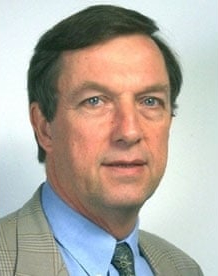David Cockayne facts for kids
Quick facts for kids
David Cockayne
|
|
|---|---|
 |
|
| Born |
David John Hugh Cockayne
19 March 1942 |
| Died | 22 December 2010 (aged 68) |
| Resting place | Oxford |
| Alma mater |
|
| Known for |
|
| Spouse(s) | Jean Kerr |
| Children | Sophie, Tamsin and James |
| Awards | See list |
| Scientific career | |
| Fields | Materials Science |
| Thesis | Electron microscope images of defects in crystal lattices (1970) |
David John Hugh Cockayne was a very important scientist. He studied materials using special microscopes. He was a professor at the University of Oxford. He also led a big international group of scientists who used microscopes.
David Cockayne was famous for helping to create a powerful way to look at tiny things. This method is called "weak-beam transmission electron microscopy (TEM)." It helped scientists study super small materials. These included quantum dots, fullerenes, and semiconductors.
Contents
About David Cockayne
David Cockayne was born in Balham, London, on March 19, 1942. When he was 8, his family moved to Melbourne, Australia. They settled in the Geelong area. David went to a new school in Geelong. He won a scholarship to Geelong Grammar School in 1953. There, he was excellent at chemistry, physics, and mathematics.
His Education and Early Career
In 1961, David started studying physics at the University of Melbourne. He graduated with top honors in 1964. He then did research on how electrons scatter. This earned him a Master of Science degree in 1966.
After that, he received a special scholarship. It allowed him to study for his doctorate (DPhil) at Magdalen College, Oxford. In 1966, David joined the Department of Metallurgy in Oxford. He researched how electron microscopes show flaws in crystal structures. He earned his DPhil degree in 1970.
Leading Research in Australia
At 32, David Cockayne became the director of the Electron Microscope Unit (EMU) at the University of Sydney in Australia. This was in June 1974. He also became an associate professor. He was promoted to full professor in 1986. Then, in 1992, he became a special professor in Physics.
He built an important research center in Sydney. With another scientist, David McKenzie, he developed a very precise way to use electron diffraction. This helped them study the structure of materials that don't have a regular crystal shape.
Return to Oxford
In 2000, David Cockayne moved back to Oxford. He became a professor at the Department of Materials, University of Oxford. He also became a special fellow at Linacre College, Oxford. At Oxford, he created an amazing group of electron microscopy researchers. He continued his studies on tiny crystals called quantum dots. These are found in semiconductor materials.
His Life and Family
David Cockayne was known as an inspiring teacher and guide. He cared deeply about research, teaching, and running the university. He brought clear thinking and strong dedication to all his work. He also enjoyed theatre, music, books, photography, travel, and hiking.
He met Jean Kerr when they were both students at Melbourne University. They became close friends and got engaged in 1966. They married in Shilton, Oxfordshire in 1967. They had three children: Sophie, Tamsin, and James.
David Cockayne passed away on December 22, 2010.
Awards and Recognitions
David Cockayne received many honors for his work. Here are some of them:
- 1985–87: Vice-President, Australian Institute of Science and Technology
- 1986–88: First President, Australian Society for Electron Microscopy
- 1986–94: Chairman, National Committee for Electron Microscopy, Australian Academy of Science
- 1999: Became a Fellow of the Royal Society (FRS). This is a very high honor for scientists.
- 2000–09: Professorial Fellow of Linacre College, University of Oxford
- 2002–06: President, International Federation of Societies for Microscopy
- 2009: Received the Massey Medal from the UK and Australian Institute of Physics
When he became a Fellow of the Royal Society in 1999, they recognized his important work. They noted that he greatly improved electron microscopy. He helped create the "weak beam" technique. This method made it possible to see tiny flaws in materials much more clearly. It helped scientists understand how these flaws affect materials. His work also helped show how tiny parts of semiconductors are arranged. He also developed a powerful way to study materials that don't have a regular crystal structure. This helped in understanding new forms of carbon, like C60 and C70.

